Cleaning brass coins
Brass coins are not often found. As a rule, they are traditionally made from copper or bronze. However, such items can also be found in collections. Despite the high wear resistance of brass, coins tend to oxidize and corrode over time. You can clean brass coins at home in the following ways.
- Cleaning brass coins with soap. This method is the most gentle for the alloy. Ordinary baby or laundry soap is rubbed on a grater and the soap gruel is dipped into boiling water. The mixture should be stirred until a homogeneous mass is formed. Then coins are immersed in it for a while. After obtaining a satisfactory result, the products are removed from the composition and washed under running water with a toothbrush. The only drawback of this procedure is that it is time consuming. Although the result is worth it.
- Removal of oxide and dirt with citric acid. The acid is also suitable for cleaning copper coins. Citric acid is diluted in ordinary water. Coins are immersed in the liquid for a while, sometimes they are turned over for uniform cleaning. They are removed after obtaining the desired result. The procedure is quite long, it directly depends on the amount of acid, on average it takes about 10 minutes. The seized coins are washed from the solution with running water.
- Cleaning brass coins with vinegar. A very convenient and efficient way. However, vinegar may not be suitable for all coins - it all depends on their constituent components. The process is quite simple - a brass coin is dipped in a vessel of vinegar for several days. Finally, the product is rinsed with running water and wiped with a cloth. After such cleaning, the coin can shine like new or, conversely, significantly worsen its appearance. The procedure needs careful monitoring.
- Coca-Cola is an effective purifier. Sweet water can remove dirt and excess patina from coins as it contains phosphoric acid. In general, Coca-Cola is suitable for light soiling, but not effective over more complex plaques.
There are other options, such as a brass cleaner with oxalic acid. The cleaning method is individually selected for each type of coin, because all products have a different composition.
So, it became clear how to clean the brass yourself and choose the most acceptable method without much difficulty. If objects suddenly become dirty or they have lost their former appearance, these recommendations will help to cope with the problem and remove unwanted oxides, while preventing the products from losing their shine and value.
June 28
, Alexandra Bondareva
Tin, nickel, manganese, aluminum and lead are often added in the manufacture of brass. The properties and color of an alloy directly determines its composition. Brass products can take on a golden, greenish or yellow tint.
It is not for nothing that brass is also called "eternal metal" - products made from this material have excellent wear resistance, they are practically not subject to temporary influences and do not lose their original state. The material is light and plastic, and therefore has become widespread in the manufacture of various kinds of jewelry.
Folk remedies
Most people do not want to clean brass with chemicals, and therefore are increasingly using all kinds of folk remedies:
- Toothpaste. Before proceeding with the processing of the product, it should be thoroughly washed with soapy water. This will soften stubborn stains somewhat. After that, the substance itself is applied to the problem areas.You can rub with a simple napkin or an ordinary toothbrush, which is able to penetrate into more difficult-to-reach places.
- Vinegar. To clean the product, you need not pure vinegar, but its mixture with water and flour. To prepare the composition, you need to take all these ingredients in equal proportions and mix well with each other. After the composition is tightly applied to any product and dries on it for some time. After complete drying, it is enough to wipe the product with a wet rag and wash off all the mixture from it. If after the first procedure the spots do not completely disappear, then it can be repeated.
- Lemon juice with salt. To polish a brass product with citrus and salt, take half a lemon and squeeze all the juice out of it. You need to gradually add table salt to it. The amount of the latter may be required differently, so you should focus on the resulting composition - it should be pasty. After preparing the mixture, it must be applied to the object with a fairly dense layer. In this case, movements must be careful. The remains of the drug must be washed off with running water, and then dry the surface with a dry and soft cloth.
- Soap solution. Soaking an object in a soapy solution can be used both as an independent cleaning, and as an additional step in any of the above methods. In the event that spots on the product have just appeared, then a soap solution is enough. In order to dull to work with the composition, you need to take any container (depending on the object), pour boiled water and dissolve the shavings of laundry soap in it with the addition of any dish detergent. After that, the composition must be foamed and immediately immersed in brass objects. You need to keep them until the liquid cools down. Then all the water is drained, and the cleaned products are washed with running water.
How to clean brass with special products?
List of cleaning products:
- Nowadays, you can buy a variety of products with the presence of acids. These are Silit Beng, Ayos, samtex, Milam, domotec. Look for oxalic acid products in household chemicals stores. They usually only take a few minutes to apply. Brass darkens when exposed to acid. This plaque can be easily removed with the rough side of a sponge and soapy water.
- You can clean brass products using special products. They are called Metalin and Dali. They contain acid, which corrodes the dirt on the metal surface. In addition, other acidic substances will be helpful.
- A special metal cleaner is available from the Amway chain company. We rub the surface with this tool and get an extraordinary novelty and shine. Here is a link to this tool for metal surfaces.
Brass cleaning
How to remove "non-critical" tarnishing
Toothpaste
Toothpaste helps well when tarnishing "moderate severity":
-
First, wash the brass thoroughly in soapy water or detergent solution.
-
Then you put toothpaste on the brush and start brushing. Do not be too zealous, do everything calmly, the dirt and so quickly will begin to "go away". If after 10 minutes there is no result, stop this business and try more serious cleaning products.
-
At the end, wash the brass items with running water and wipe thoroughly with a dry soft cloth.
Another helpful article: How to clean a glass ceramic hob
Ketchup
Not every ketchup is suitable for cleaning, but only one with a minimum of dyes and a maximum of "acid" preservatives.
-
You put ketchup on a sponge and rub over oxidized brass objects.
-
Do not touch for 20 minutes, and then remove with a cotton or terry cloth hard cloth.
-
Wash and wipe with a dry cloth.
Another helpful article: How to clean a suede jacket at home
Yogurt
Yogurt is another good brass cleaner.The more lactic acid it contains, the better the result will be.
-
You pour yogurt into a saucepan, put tarnished figurines and earrings in it.
-
You don't take it out for about an hour.
-
Then you wash the brass products with water and wipe them with a soft cloth.
Remember: Brass is very easy to scratch, so if you have long nails, handle the alloy with extreme caution.
Oxalic acid detergent
Oxalic acid is often found in detergents. It is good for cleaning brass surfaces that begin to oxidize.
-
Apply sorrel to the darkened areas.
-
You leave it for a short time (half an hour is enough). Don't worry when you see the dirty places get darker. This is the way it should be. It's just that the acidic coating began to separate from the brass surface.
-
Running water and a soft-bristled brush "dispel the darkness."
-
Now apply a little baking soda and use a wet cloth to go over the remaining dirt.
-
Wash with water and wipe thoroughly with some soft cloth.
Soap solution
Helps only with relatively light dirt.
-
You pour lukewarm water into a basin and add some kind of detergent or soap (preferably household).
-
Foam the solution.
-
You dip dull brass into it. Keep there until the solution begins to cool (that is, a maximum of 10 minutes).
-
You take out your figurines and ringlets. You start brushing them with a soft-bristled brush. In parallel, wash with lukewarm water.
-
Wipe with a soft cloth.
Important: After cleaning, always polish the brass with a special polish. If this is not done, it will be difficult to achieve the desired shine.
arrow_leftPolished brass reflects the world like a mirror.
Lime and soda
Lime in a company with soda does a good job with brass oxidation:
-
Add 60 g of regular soda to 50 ml of water.
-
Sponge the resulting mixture onto the brass. Don't touch for 20 minutes.
-
Now cut the lime in half.
-
Treat your brass items with this citrus pulp. Then leave it alone for 40 minutes.
-
Wash with water and wipe.
If the desired result is not there, repeat the process again. On the second try, you will almost certainly clear it.
Remember: Unlacquered brass is much more difficult to clean than varnished brass, because oxide eats into its unprotected surface much deeper. Conventional detergent cannot be dispensed with.
Folk methods
It is not uncommon for housewives to use time-honored folk methods to clean kitchen items or brass jewelry. If you use the tools at hand, you can achieve their original appearance. The most common remedies include:
- Acetone. You can remove dirt by wiping the item with a well-moistened cotton swab in acetone or nail polish remover. This tool effectively removes copper oxides. However, it is the oxides that give it a unique flavor.
- Acetic acid, vinegar, table salt. A hot solution is being prepared. First you need to dilute 1 tbsp. l. salt in 2 liters of water with the addition of vinegar (half a glass). A well-mixed composition must be put on fire and brought to a boil. Immerse brass products in boiling liquid for 4 hours and add ordinary water if necessary. After boiling completely, all stains from the item will be removed. Finally, a textile polish will give the item a shine and shine. Vinegar works if the item is oxidized for a short time.
- Flour and vinegar. The dough is kneaded in proportion: 200 g of flour and 1: 1 water with vinegar. Contaminated items are coated with sour dough and remain in this position until completely dry. Then the dough is removed with a regular cloth. This method is suitable not only for cleaning such an alloy, but also objects that contain a certain percentage of copper. Brass polished and cleaned in this way will look like new.
- Table salt and lemon. 1 lemon is cut into two halves, and one half is well covered with ordinary salt.After that, the contaminated surface of the product is coated. This brass cleaner is considered to be very effective and the easiest to use at home.
- Abrasive substances. The most common remedies are toothpaste or sandpaper. First you need to prepare the item for cleaning with toothpaste: wash the brass item with soapy water. Then you can clean it with a paste using a brush or rag. The second option is suitable for cleaning heavily soiled surfaces. It is preferable to choose only fine sandpaper.
You should know! To clean jewelry and other interior items from this alloy, you need to use only special products. If you remove oxides and dirt using methods that are not suitable for the product, you can damage the item. Polishing metal in fabric gloves prevents unwanted contamination from occurring.
To date, specialized products for cleaning brass are sold on store shelves, for example, Metalin and Delhi. They include acids with a concentration of up to 20%. Various acids and a composition of ammonia and ammonium carbonate also effectively purify the alloy.
Cleaning the alloy with acids such as acetic, hydrochloric or citric acids must be very careful, as the wrong approach to processing can significantly worsen the condition of the object.
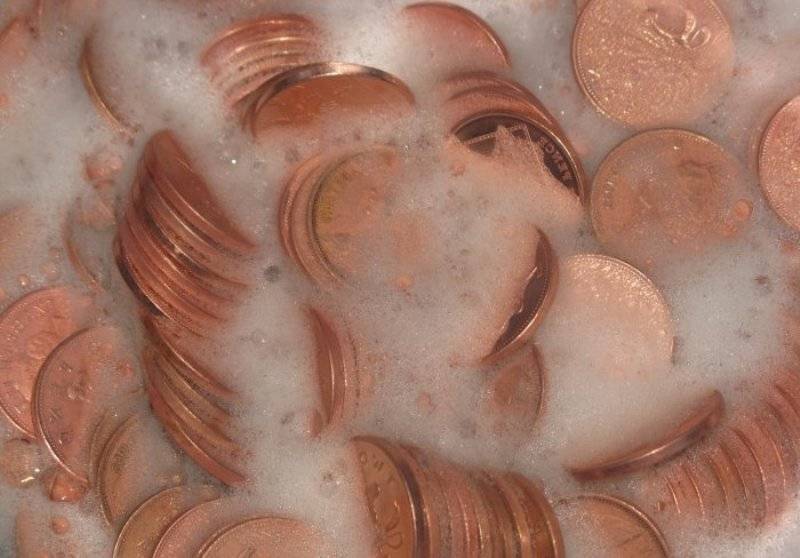
Folk remedies
Brass has very ancient origins. It was admired by the ancient Romans and was widely used by recognized masters of the East. And it is not surprising that a collection of folk methods for cleaning this alloy has been collected by our time.
And therefore, before cleaning the product using professional tools, you should pay attention to the recipes created by observing and correcting previous errors:
For this recipe, you need to knead the dough: 200 g of flour and vinegar with water 1: 1.
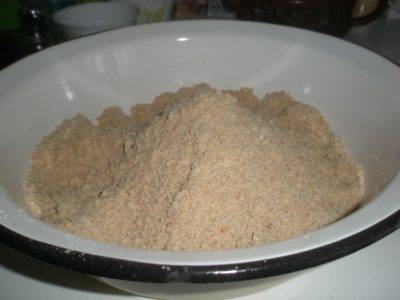
The consistency of the dough should be slightly denser than the pancake. The resulting product is coated with plaque and left to dry. After the dough has completely dried, the surface is treated with a soft cloth. The vinegar contained in the dough will dissolve the oxides, and the flour will absorb them.
This method of cleaning is very interesting, it was widely used in Russia.
For this, cranberries, which contain citric and oxalic acid, are rubbed into the product, thereby effectively dissolving the oxide. After standing for 15 minutes, remove the cranberries and wash with water.
This method is based on exposure of dense plaque to carbon dioxide.
Add 1 tsp to 200 ml of buttermilk. salt, an active reaction begins, as a result of which carbon dioxide is produced - the strongest solvent for the oxide. The composition is used to wipe problem areas and wash off the residues with water.
For minor contamination, a slice of lemon will help to remove stains, which must be dipped in fine salt.
Cleaning brass at home is not as difficult as it seems at first glance. It is much easier and safer for a unique alloy when a person understands the properties of brass and uses detailed recommendations.
Change of varnishing
If neither "tin" nor light means help, you will have to change the varnishing. But don't be alarmed. There is nothing difficult in replacing this one, it is simple to do it at home:
-
Spread out a waterproof film so that the removable varnish does not stain the floor. Put on a dressing gown or overalls.
-
Take a special liquid intended for varnish remover, soak a brush into it and start driving it over the varnish. So you will remove the varnish. Be sure to use a respirator and gloves, do not light matches - the varnish remover is usually flammable.
-
Now the brass needs to be polished. Use special tools for this - polishes.
-
Rub the polish into your jewelry and figurines, then polish until they start to shine.
-
It's time to start applying a new varnish. Spread it over the brass surface in an even thin layer. The best way to do this is with a brush.But if the artist is not so hot of you, use cotton circles.
-
Now wait for the varnish to dry thoroughly.
-
Wipe your brass items with a soft, dry cloth.
If there is no polishing on your brass, and nothing can be done to clean the alloy, then there is only one way out - to contact a specialist.
And a video "on the topic" in the end:
- How to wipe off the traces of the handle from leatherette
- How to clean plasticine from clothes
- How to clean gold plated silver at home
- How to clean salt from suede boots
Brass cleaners
To clean brass at home, you do not need to purchase any complicated apparatus and devices. All that may be needed for work is protective gloves, a respirator, a soft brush or sponge, soap. You may need a small magnet to help you determine if the item to be cleaned is actually made of brass. If the magnet will not be attracted to the object, it is brass.
Oxalic acid
Oxalic acid is the most common and affordable way to remove oxides from brass and give it its original shine and color. In its pure form, this product is sold in the form of a powder, packaged in packages from 20 grams to one kilogram, in bottles of 100 grams, in balloons, in liquid form.
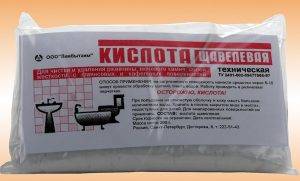 Oxalic acid
Oxalic acid
In addition, oxalic acid is found in many kitchen cleaning fluids, as it perfectly cleans not only brass, but also many metal objects.
Detergent containing this acid should be applied to the item to be cleaned and left for half an hour. Interacting with oxalic acid, brass will begin to darken, a dark coating will appear on the surface of the object.
After the allotted time has elapsed, the object should be rinsed with water under high pressure, cleaning off the formed plaque with a soft brush. For greater effect, the item should be covered with baking soda for a few minutes, and then rinsed again with water.
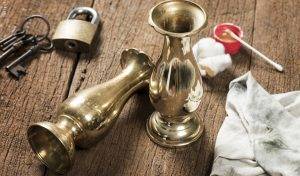 Cleaning brass with oxalic acid
Cleaning brass with oxalic acid
It may happen that the brass cannot be cleaned with a detergent. Then you should prepare a solution of oxalic acid in the amount necessary to completely cover the object, at the rate of 20 milliliters of oxalic acid per liter of water.
Immerse a brass product in this solution, stand for 15 minutes, rinse with a strong stream of water. Wash the cleaned item thoroughly with warm water and soap, rinse and dry. You need to work in protective gloves and a respirator.
Other ways to clean brass
From other improvised means, to clean brass, you will need in different combinations:
- salt;
- vinegar;
- acetic acid;
- baking soda;
- lemon;
- lemon acid;
- household acetone;
- cotton pads;
- soap or regular shampoo.
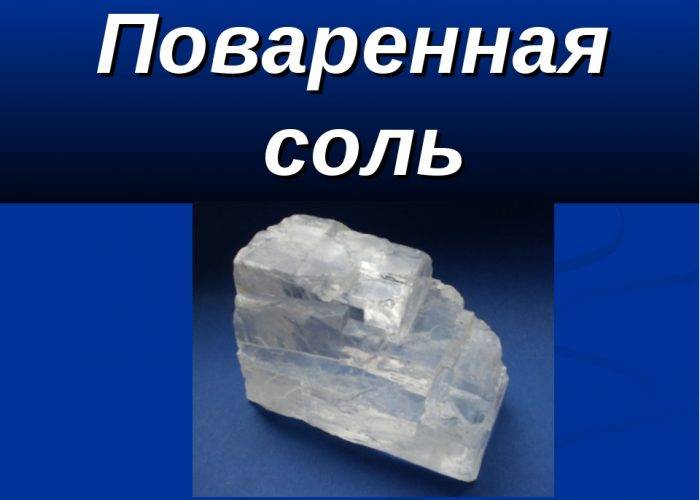
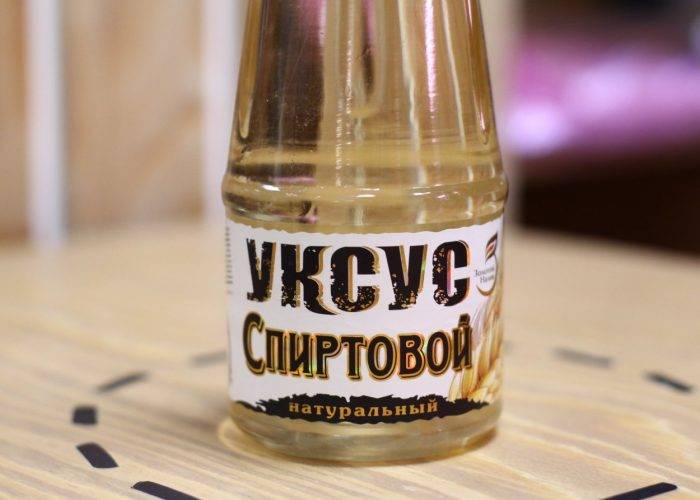
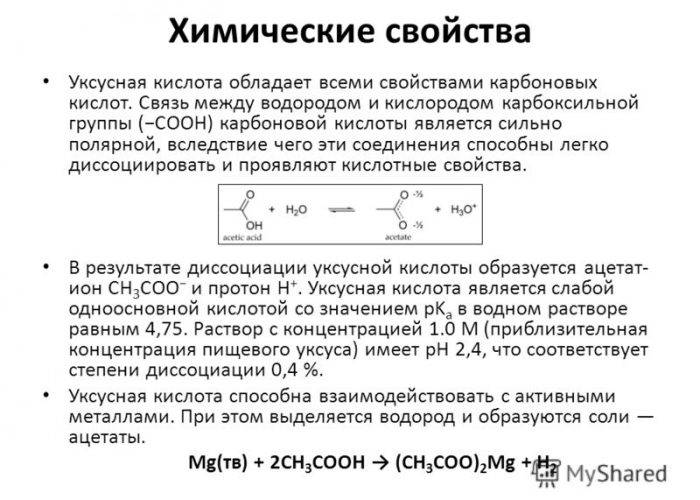
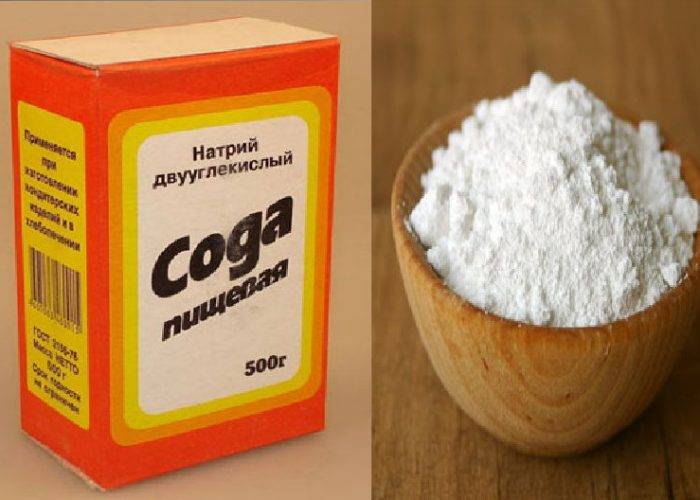

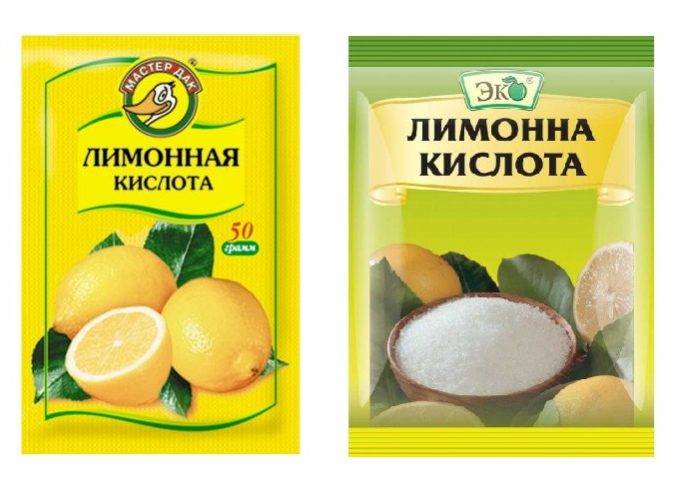
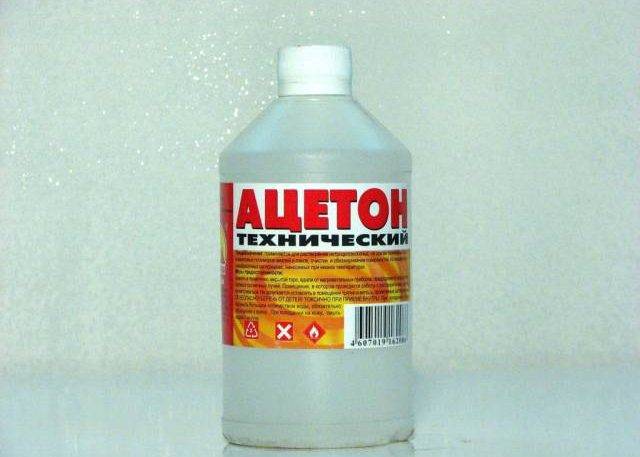
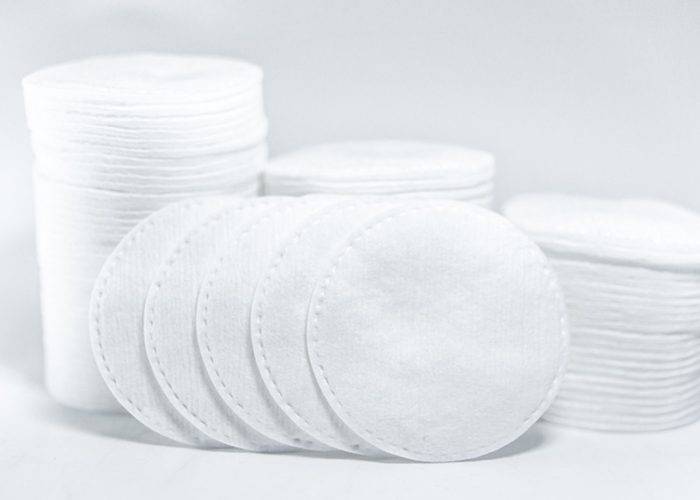
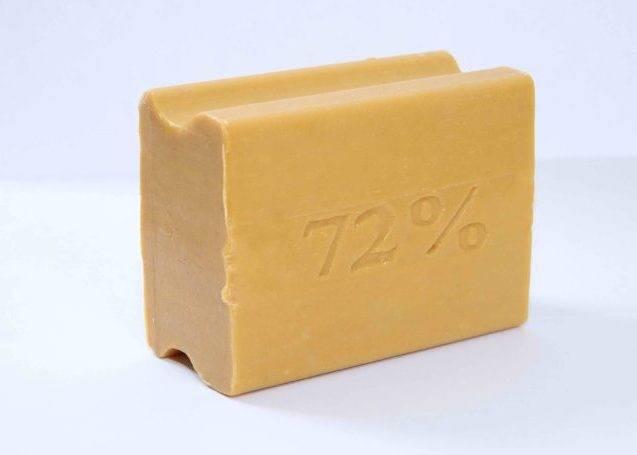
To clean the brass surface with acetone, you need to moisten a cotton pad with it, wipe the dirty areas, then rinse the accessory in warm soapy water, then wipe dry with a strong stream of running water. Stubborn dirt can be cleaned with ordinary table salt mixed with the juice of half a lemon. Cleaned brass products should be washed in soapy water, then running water, and then dry thoroughly.
A longer, but more effective way is to use table salt and 9% vinegar or acetic acid. An aqueous solution is prepared, heated, a brass accessory is dipped into it and boiled. The process lasts three to four hours. With this method, the metal surface will be cleaned from both dirt and oxides. After cleaning, an indispensable rinsing procedure in soapy water and running water. And pat dry on a soft towel.
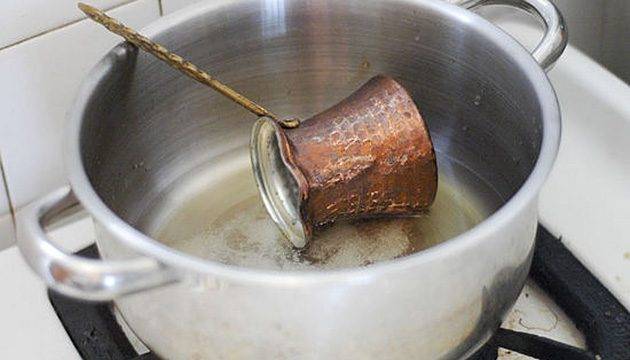
What is brass, where is it used
Brass is an alloy of copper and zinc.The material contains elements such as manganese, tin, aluminum and lead particles that change the characteristics and color shades of the metal. Zinc was discovered in the 16th century, but brass was learned to be obtained in antiquity. The metal was obtained by melting copper and zinc-bearing ores.
In the manufacture of the alloy, up to 30% zinc is added to the composition, however, up to 50% of the metal is added to improve technical characteristics. Brass practically does not wear out, it is used in the manufacture of spare parts for automotive equipment, serpentine elements, heating radiators, as well as stamped parts and various accessories. Alloyed brass is used for the production of aircraft, ships, watch parts and main pipes.
With the help of a tombak (an alloy with a zinc content of not more than 10%), insignia are made. Cast brass is used to protect the elements from corrosion. With its help, bearings, shut-off valves, and also separators are made. Due to the intrinsic properties of the alloy, compasses and heating radiators are produced. Brass cleaning is carried out without the use of additional equipment and special means.
Metal is used in jewelry making bijouterie, as well as fake gold jewelry. The content of the alloy in the alloy is up to 15% zinc and the addition of 5% aluminum makes it possible to obtain a material similar to precious. This condition is used when making the settings for icons, as well as other items in churches.
What you may need
Before moving on to cleaning metal, you need to stock up on the necessary tools and devices.
Rubber gloves
Protects the skin of the hands from the effects of cleaning agents. They are especially relevant when a person deals with chemical compounds.

Paper napkins
Necessary to remove pasty compounds from the surface of the product. They also remove excess moisture, helping the figurines dry faster. There should be plenty of napkins on hand so you don't have to interrupt work.
Container for liquids
No cleaning procedure can do without this device. Depending on the number of products and their volume, a suitable container is selected.
Cleaning methods
You should not get carried away with global cleaning and polishing. Aggressive compounds are used in special cases, since they spoil the metal in large quantities.
It is easy to restore the previous appearance to bronze products. The kitchen has a ton of tools that will come in handy in this matter. And we are talking about affordable products.
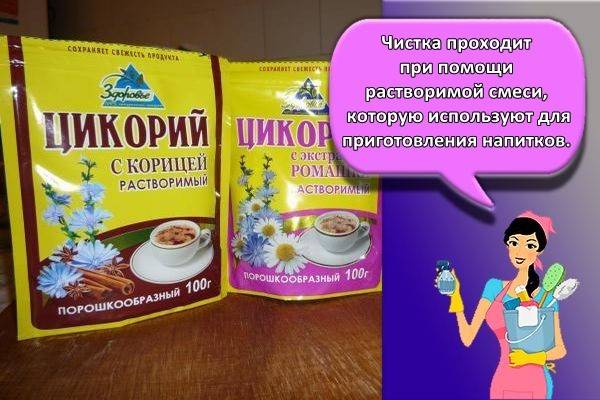
Chicory powder
Cleaning takes place using an instant mixture that is used to prepare drinks. Chicory can be purchased at any convenience store or supermarket. Cleaning takes place as follows:
- The purchased powder is poured into a bowl.
- By gradually adding water, the mixture is stirred. The resulting mass should resemble dough in appearance.
- Bronze items are processed with this composition.
- Residues are removed with a brush.
- At the end of cleaning, the items are rinsed in water, dried with a towel and dried.
The method is suitable for cleaning small items.
Lemon juice and soda
Stages of cleaning with this method:
- Dust and foreign particles are washed off with warm water.
- In a container, mix the juice of half a lemon and 2 tbsp. l. soda.
- A homogeneous mass is applied to the product.
- Using a cloth, make circular movements until the spots disappear.
- After that, the gruel is left for 15-20 minutes.
- At the end, it is washed off with warm water, and the item is wiped dry with a cloth.

With this recipe, you can restore the lost shine. The procedure is repeated if necessary.
Peas
An excellent method for removing a layer of dust that has remained on the surface of the product for a long time. Cleaning steps:
- Peas are poured into a large pan and items that need to be cleaned are sent there.
- The container is filled with water so that the products are completely covered.
- The saucepan should be on fire for several hours.
- After that, the items are moved into warm water.
- Remains of peas are removed with a soft brush.
Pea paste
You will need yellow peas to cook it. It is boiled until tender, at the end, rubbing until it becomes a thick gruel. Problem areas are covered with paste.
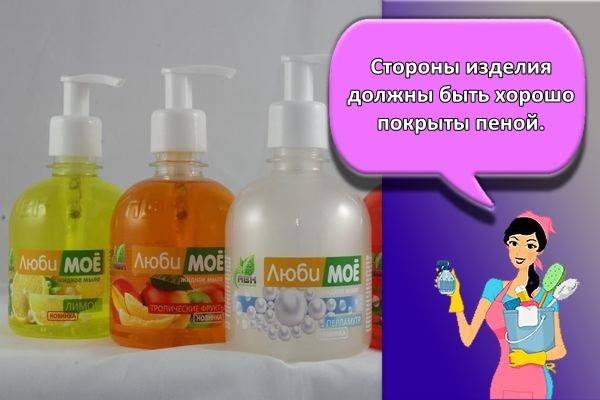
As soon as the pea mass is dry, they start cleaning. Products are washed in boiled water, using a brush if necessary. The figurines are wiped dry with a piece of cloth.
Soap and boiling water
The next method allows you to remove dirt from bronze objects and restore their previous appearance. As soon as the water boils in the pan, bronze objects are dropped into it. After 3 minutes, liquid soap is added to the water.
The sides of the product should be well covered with foam. After the performed manipulations, the surface is cleaned of soap and dirt. This is where flannel fabric comes in handy.
Citric acid solution
The powder is mixed with soda. Warm water is added to the mixture and mixed thoroughly. If there are no grains left in the liquid, the solution is ready for use.
Vinegar dough
To prepare an unusual cleaning product, you will need wheat flour, salt and vinegar. Cleaning with vinegar dough is started after the product has been pre-washed and dried.
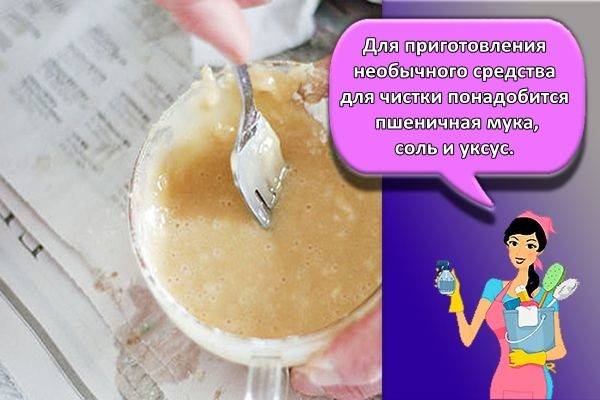
Cleaning method:
- The prepared ingredients are mixed in equal quantities, except for vinegar.
- Add liquid at the end. The mixture should resemble a thick dough consistency.
- The finished composition is applied to problem areas and thoroughly rubbed.
- Actions are repeated three times.
- The product should remain on the surface until the patina is removed. This may take from 30 minutes to 1.5 hours.
The mixture is removed from the figurines with warm water
The products are wiped off with paper napkins, paying great attention to depressions and depressions. Not a drop of moisture should remain on bronze objects
If there is no desire and time to prepare cleaning products yourself, you can buy a ready-made composition.
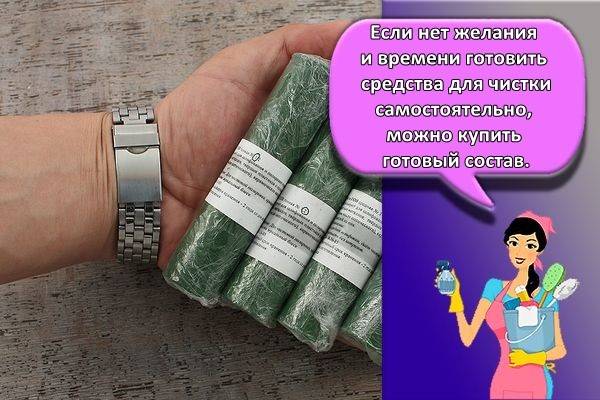
Sawdust
The method seems exotic, but was popular in ancient times. The sawdust is mixed with vinegar in a glass container. Bronze objects are rubbed with swollen shavings.
For convenience, sawdust is collected in fabric, and in this form the products are processed. The dirty mixture is thrown away and a new batch is taken for effective cleaning. The final stage is washing in warm water and wiping dry.
Aggressive cleaning methods
Experts do not recommend using citric, hydrochloric and acetic acids to clean brass. The fact is that these are strong acids and if you do not strictly follow the instructions or make a mistake somewhere, you can harm the alloy. But if the possible consequences do not scare you, or the condition of the product is so bad that it will be difficult to get to the brass itself, then we bring up the list of recipes:
Take a fresh lemon and cut it in half. We take one of them and sprinkle well with salt.
Now we apply it to the product and carefully, slowly, clean it to a shine. We rinse with water and wash off the leftover lemon, now dry it
The method will cope with even the most difficult cases.
Fresh oxide can be easily removed with hot vinegar. To do this, put it on fire and bring it to a boil. We moisten a cloth and rub it into the product. As a rule, all the dirt literally disappears before our eyes.
How to clean brass at home if it is invisible from under the plaque? We take 3 liters of water, add half a glass of vinegar and a tablespoon of salt. Bring to a boil, smoothly immerse the brass object there. We leave for 3 hours and observe from time to time to control the water level, top up if necessary. Leave to cool slightly and remove the product, wipe with a soft cloth. If necessary, you can now polish, the thing will be easy to give in to it.
These 3 methods are used to clean brass in the most difficult cases. Use only if no other method works.If used ineptly, you can easily damage the alloy and permanently ruin its appearance.
For another method of cleaning brass, see the video:
Folk remedies to combat pollution on brass
Many people are wary of using strong chemicals to clean their products. That is why the people have come up with cleaning products that are absolutely harmless to humans and do not require the use of special safety measures.
- Toothpastes - this hygiene item can be easily found in every home. In order to clean a brass object, first immerse it in soap and water to soften the dirt and remove the lightest. After that, you need to apply toothpaste to the remaining part with dirt, while using a toothbrush for a more thorough cleaning (especially if there are hard-to-reach places). Also, sometimes a simple napkin is used so as not to damage the product.
- Vinegar - the following solution is also used for cleaning: 1 glass of flour, 1 glass of water and table vinegar. After that, the resulting mixture is applied to the contaminated areas of the product, and then wait a while until it dries completely. The solution acts in such a way that the flour gradually absorbs the main dirt, and the vinegar dissolves the deposits. Then you need to walk over the product with a cloth napkin. If after the first time all the contamination is not gone, then the procedure is repeated again.
- A solution of lemon juice and salt - to prepare this product, first of all, squeeze the juice from half a lemon. Then gradually add edible salt to the resulting juice until the resulting mixture looks like a paste. Apply the resulting solution to the product, and then remove dirt with small movements using a rag. Then the composition must be washed off with running water, and the object itself must be dried.
- Soap solution - most often this method is used as a preparatory method for basic cleaning. However, if the contamination of the object is insignificant, then the soap solution will be able to remove them without difficulty. The item should be soaked in warm soapy water in a basin for a while. Then you need to wait until the liquid has completely cooled down. Then, with a brush, you should clean the main dirt on the product and rinse it off under normal water (an acceptable method for cleaning coins and mech mod).
- Hot vinegar solution - this remedy can help if foreign stains appear on the product. Heat the vinegar and then wet a cotton ball. Can I start removing stains on the subject after this? Without a doubt. Since vinegar has a pungent odor, the apartment or house is thoroughly ventilated when using this cleaning method.
- Sandpaper is often used for cleaning items such as candlesticks and fireplaces. If the objects have stains of soot, then it is enough to walk on them with sandpaper. However, it is better then to do additional cleaning with chemicals.
- Salt and buttermilk composition - use the following mixture for cleaning: add 1 tbsp of buttermilk to 0.5 liters of buttermilk. spoon of salt and mix this solution. This solution is suitable for the treatment of particularly contaminated areas - after application, the product must be rinsed under running water and dried. Can be used for cleaned mech mod.
Video: how to clean brass products at home?


